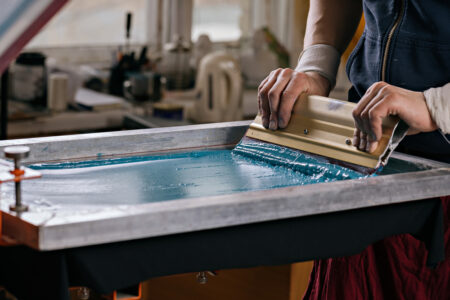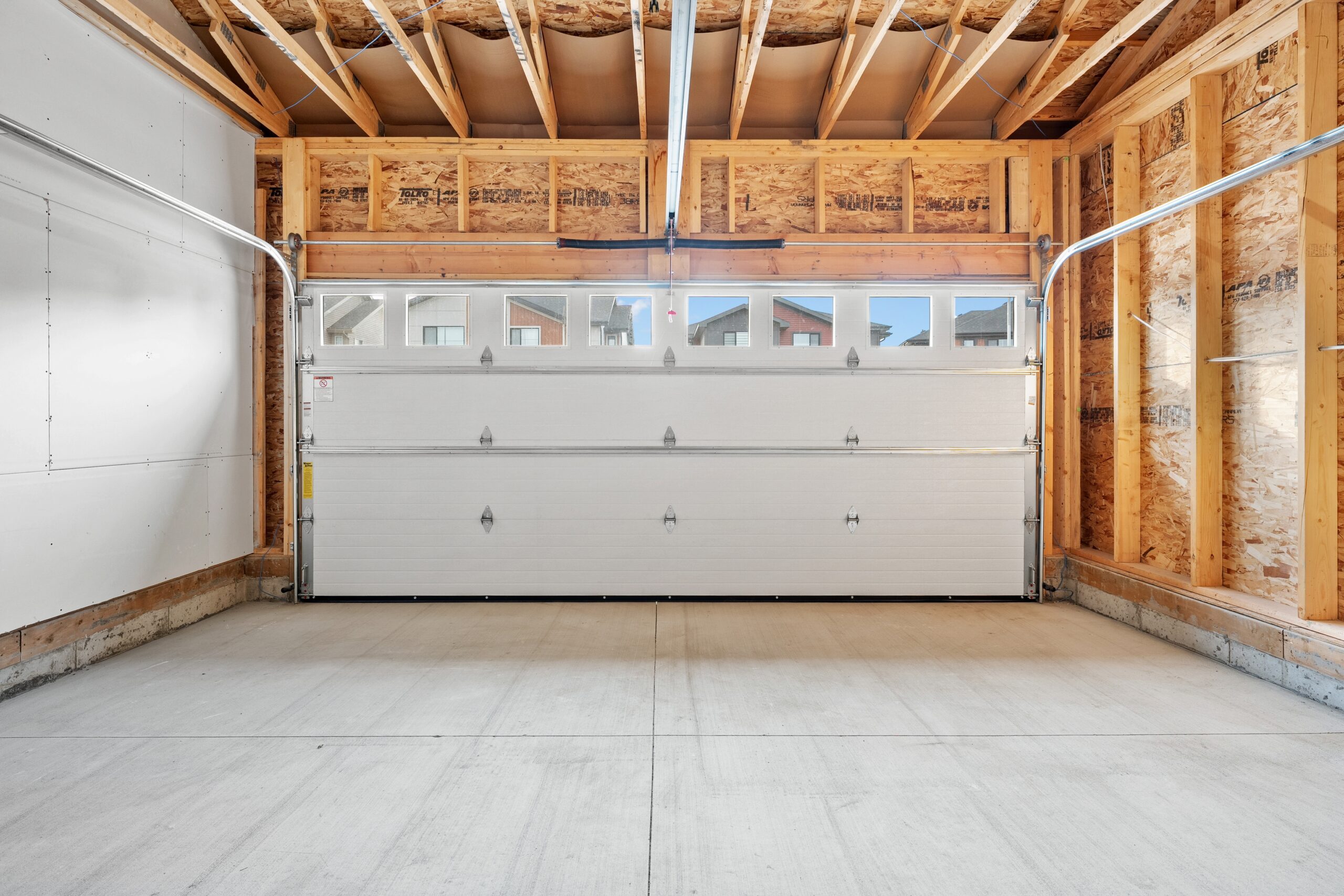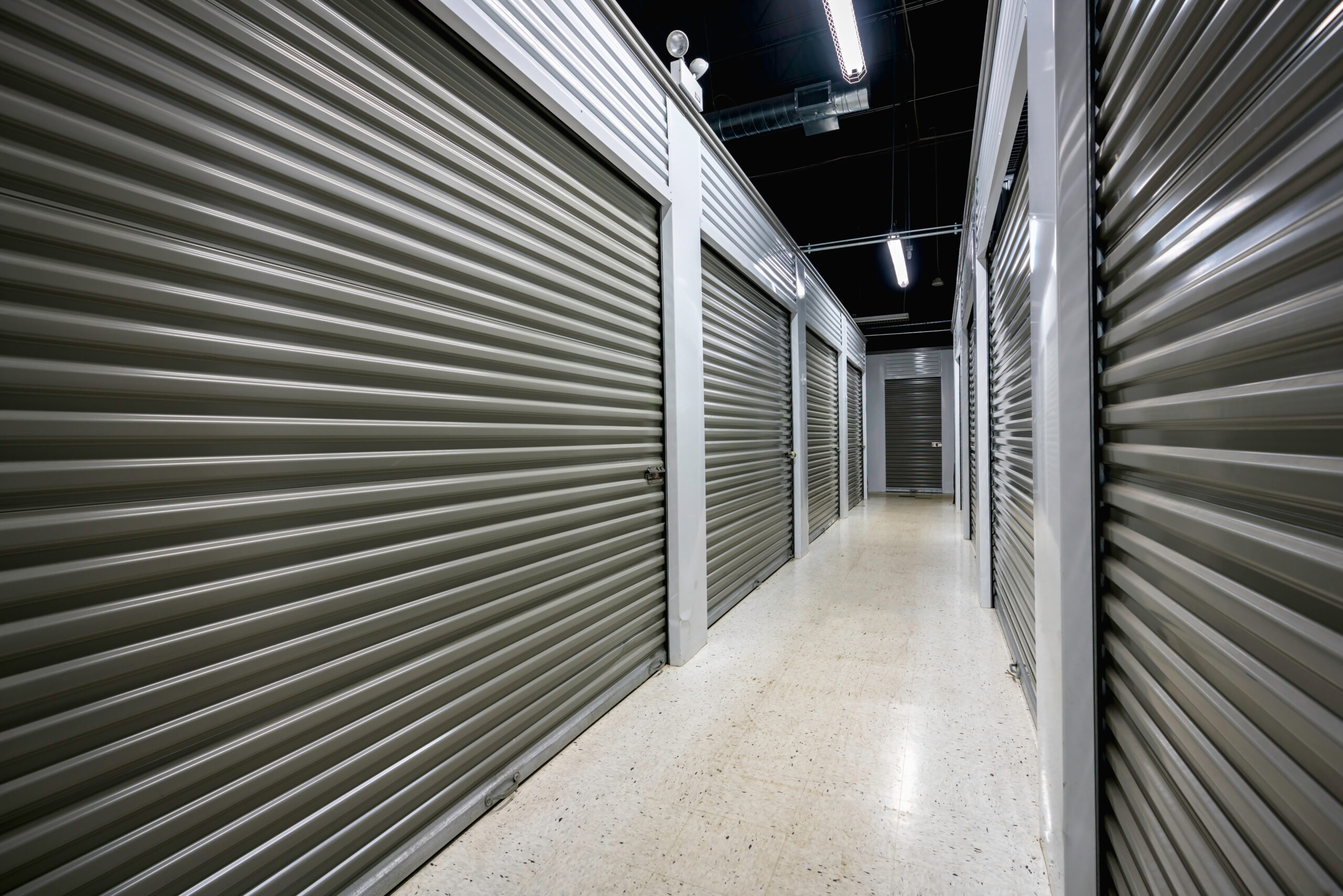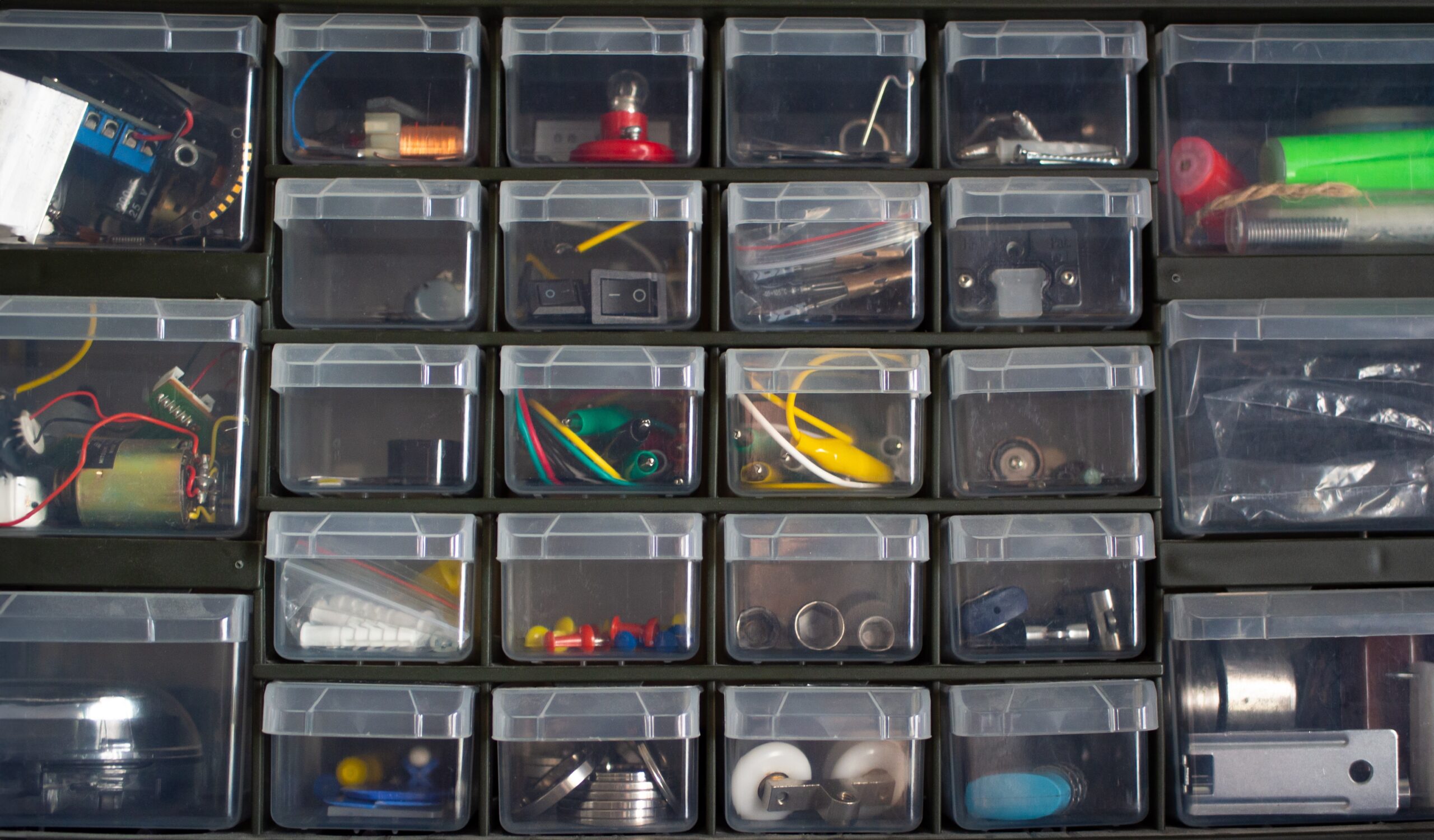For the professional artist, properly storing art supplies isn’t an option, it’s a necessity.
If you create for a living, you probably learned very early on the importance of ensuring your creative materials are well organized, maintained and properly stored. Whether you’re working from a home studio, renting a separate workspace, or considering self-storage options for your work, the right approach can save you time, money, and the frustration of wasted or ruined materials. Proper storage not only protects your supplies and artwork, it also keeps your work organized so your creative workflow is smooth and efficient.
A well-thought-out approach to art material storage and art supply organization will ensure both your studio and your creative mental space remain uncluttered and ready at a moment’s notice to create your greatest masterpiece. From choosing the right long-term art storage location to the right everyday art supply storage containers and organizers, we’ll explore how professional artists like you can maintain a tidy, functional workspace to help eliminate wasting your valuable time and money, and maximize your creative productivity.
Art Material Storage: Home, Studio, or Self-Storage Unit?
It’s essential we assess your unique needs before choosing the correct storage solution, as every artist has different requirements depending on the materials they use, the size of their work and their available space. In-home storage is convenient, but a dedicated art studio may provide more space and offer specialized safety solutions for storing hazardous materials. An art storage unit is a great option for short-term storage if you are planning a move, or as long-term or permanent housing for larger creative works or hazardous supplies.
In-home Storage Solutions:
Storing art supplies in your home is ideal if your medium doesn’t require a lot of space, such as needlework, digital photography, portraiture or even some types of woodworking. In-home art material storage is cost-effective and ensures tools are easily portable and readily available to you whenever inspiration strikes. However, space limitations or constraints could lead to clutter if your supplies are not carefully and routinely organized, and fluctuations in your home environment could affect the lifespan of sensitive materials.
Art Studio or Self-Storage Solutions:
An extended art studio or self-storage unit may be right for you if you have a sizable collection of tools and materials, or if your work requires large-scale equipment. An extended art studio or art storage unit will provide customizable climate controls to keep your materials in workable condition and should have plenty of storage uniquely designed for artists’ supplies. Be sure to consider the ongoing costs of renting or owning an extended studio space or storage unit, the security and operating hours of your art storage unit, and whether commuting to retrieve materials at an off-site storage location might inconvenience your creative process.
How to Store Art Supplies: Tips for Every Type of Artist
The right art material storage solution for you will depend on the creative field in which you work, and the tools and supplies you use. Whether you’re working with pastels, watercolors, or digital media, it’s essential to understand how to store art supplies and artwork according to the needs of your chosen medium. When thinking about art material storage, accounting for every form factor and dependency–from weight, height and width to specialized climate requirements–is crucial to a successful storage experience.
If space is tight, knowing how to organize art supplies in a small space—such as shelving, vertical storage or acid-free boxes—can help. For larger collections, placing a high priority on accessibility, labeling, and organization within an art storage unit will save precious time and keep stress at a minimum when you need to find something quickly.
Consider the heft and resiliency of your materials as well–heavier items like sculptures or canvases may need padding or careful placement, while delicate art should be stored in archival-quality containers to prevent deterioration. Knowing the specific needs of your chosen medium is the foundation for effective art material storage.
Painting and Printmaking

Commonly Stored Items: Oil paints, acrylics, watercolors, inks, solvents, brushes, rollers, canvases, printing plates, screens, paper
Specific Storage Needs: Temperature regulation, airtight containers, light protection, vertical storage for canvases, solvent safety
Storage Recommendations: Store inks and paints in airtight containers to prevent drying out; place in a cool, dry place and maintain a regulated temperature. Seal solvent containers tightly. Use brush organizers. Store canvases upright. Use archival-quality paper storage.
Metalsmithing and Jewelry

Commonly Stored Items: Metals, sheets, wire, hammers, pliers, torches, acids, patinas, polishing compounds, gemstones
Specific Storage Needs: Rust prevention, chemical safety, organized tool storage, gemstone protection
Storage Recommendations: Store metals in a dry environments with silica gel packs to prevent rust. Use rust-inhibiting sprays on tools. Use storage containers or jewelry boxes with dividers and soft padding for small items like gemstones and jewelry clasps. Store chemicals in labeled, carefully sealed containers. Carefully follow any special instructions provided with chemical products to ensure safe storage.
Fibers (Textiles, Weaving, Knitting)

Commonly Stored Items: Yarns, fabrics, dyes, needles, looms, patterns, sewing machines
Specific Storage Needs: Pest control, light protection, humidity control, organized yarn and fabric storage.
Storage Recommendations: Store fibers in airtight, moisture-proof containers or cedar chests to prevent mold. Use spool racks for threads and yarns. Use acid-free tissue paper for delicate fabrics, and store in cedar drawers or bins to protect from damage and dirt. Keep dyes in sealed containers away from light. Use pegboards, shelving and hard cases for tool organization.
Woodworking

Commonly Stored Items: Lumber, saws, chisels, planes, finishes, and glues
Specific Storage Needs: Moisture control, tool rust prevention, organized lumber storage, finish safety
Storage Recommendations: Store wood pieces flat in a dry, well-ventilated area to protect them from warping. Use rust-preventative sprays on tools like chisels and planes. Store in tool chests or racks for organization. Store finishes and glues in sealed containers, away from heat.
Glassblowing

Commonly Stored Items: Glass rods/tubes, blowpipes, torches, kilns, safety equipment
Specific Storage Needs: Temperature control, organized glass storage, kiln maintenance, safety equipment storage
Storage Recommendations: Store glass rods/tubes horizontally in racks to prevent breakage. Maintain kilns according to manufacturer’s instructions. Designate a convenient area to store gloves, goggles and other safety equipment.
Sculpture and Ceramics

Commonly Stored Items: Clay, plaster, stone, metal, chisels, mallets, armatures, molds, throwing wheels
Specific Storage Needs: Weight support, material-specific storage (e.g., damp clay), tool organization, mold protection
Storage Recommendations: Store heavy materials on sturdy shelving or the floor. Keep clay in airtight containers or wrapped in damp cloths. Organize tools in racks or toolboxes. Store delicate molds in protective cases.
Photography

Commonly Stored Items: Cameras, lenses, film, prints, negatives,
hard drives/digital storage, lighting equipment, backdrops, film processing chemicals
Specific Storage Needs: Climate control, dust protection, organized digital storage, chemical safety, light protection for film
Storage Recommendations: Store cameras and lenses in padded cases with silica gel packs to prevent moisture. Store film, prints, and negatives in a cool, dry place. Back up digital files regularly. Store lighting equipment and backdrops in padded cases with silica gel packs to prevent moisture. Store chemicals in labeled, sealed containers. Carefully follow the instructions included with the product.
Can You Use an Art Storage Unit as Your Art Studio?
The idea of establishing a creative workshop in a self-storage unit can be very appealing to the artist who seeks a dedicated, affordable space to focus on creating with minimal interruptions. Storage units offer quiet, private and, in some cases, climate-controlled alternatives to the more expensive dedicated art studios, and they provide plenty of space for storing art supplies so you don’t have to sort out how to store art supplies in a small space if your needs are more expansive. While there are some benefits to using an art storage unit as a studio, there are a few things to keep in mind if you are considering this as an option.
Some facilities may prohibit using storage units as workspaces or retail locations due to zoning issues or concerns about liability, so be sure to inquire about the rules at your facility. Your art storage unit may not provide adequate lighting for your work, nor climate controls to preserve some of your materials. Noise levels, ventilation and availability to running water and restroom facilities should also be evaluated, as these factors may affect the kind of art you can create in the space, and the amount of time you can spend working there. If your work is particularly messy, you may also need to invest in coverings, tarps and cleaning materials.
Tips and Ideas on How to Store Art Supplies
Whether you will be storing art supplies in your home or you have opted for an art storage unit, there are a few organizational tips best practices to ensure you create a space with the right storage solutions to protect your materials and support the way you work:
- Keep frequently used tools within easy reach: You’ll want your materials to be ready to work when you are, so keep your most-used tools and supplies in easy reach of your workspace. Place safety gloves or goggles near your workspace for quick access, so you don’t have to search for them when it’s time to create.
- Tidy your workspace: A cluttered space can create a distracted mind, and as a professional artist you don’t need unnecessary external disarray disturbing your creative flow. Organize your workspace after each use, clean off surfaces and put tools and materials back in their cases and containers. If you are working in an art storage unit, be sure to clean any messes and pick up any debris before you leave. You can refer to our handy guide above to see our recommendations for specific storage suggestions for different art mediums.
- Maximize space: If you’ve been puzzling over how to organize art supplies in a small space or art storage unit, think vertically. shelving or stackable drawers when space is at a premium. Carefully label clear bins and file cabinets to categorize items, and to help quickly identify them when you need them.
- Safety first: As you think about how to store art supplies, be mindful of any safety precautions, especially if you have children or pets or work with hazardous materials. Dangerous materials should be placed in fireproof lockers, and away from any heat or ignition sources. You may also want to consider a self-storage unit for housing these items.
How Storage.com Can Help You Find the Right Art Supplies Storage Solution
Organization is paramount for a professional artist to be at their best. An untidy, unfocused workspace can stifle creativity, slow down momentum, and even lead to damaged or misplaced materials. The right space for storing art supplies, the right art material storage products and creating a solid art storage strategy will ensure your tools and materials are always in top shape and ready to work when you are.
Consider proper art material storage as the last step of your creative workflow–a step that protects your valuable and invaluable professional investments, and one that respects your time. Knowing your materials are well organized, protected and categorized for easy access will optimize your process, your productivity and your creative evolution.
Now that we’ve explored some options and solutions, if you think an art storage unit may be right for you and your artwork, let Storage.com help you find the unique storage facility that will fit your needs.
Frequently asked questions
How long do art supplies last?
The longevity of art supplies varies by medium, but properly stored and maintained art materials can last months to years. If your art supplies were manufactured, they should be able to provide detailed information on ideal storage conditions.
How do you pack art supplies for long-term storage?
As a general rule, art supplies should be packed in cardboard boxes or containers with bubble wrap or padded fabric depending on the medium. Packages should be stored away from sunlight and excess humidity, and protected from extreme temperature fluctuations. Silica gel packs can be placed in containers to help manage moisture.
What is the best way to store paint?
Store oil and acrylic paints upright in airtight containers, preferably in a dark, cool place. This will help keep them from drying out, especially if you are preparing them for long-term storage. An art box created specifically for paints is an excellent storage option.
What is the best way to store knitting and sewing supplies?
Organize needles, threads and yarn in labeled, see-through bins to keep them clean, dry and protected from pests. You may wish to categorize them further by color, weight or type.
Fabrics should be stored in a cool, dry place away from sunlight. Consider using cedar blocks or wrapping in acid-free paper to further protect them from mold, dust or other damage.
What is the recommended climate or temperature at which art should be stored?
Art should ideally be kept at a temperature between 70-75 degrees Fahrenheit, and 50% humidity. If you are using a self-storage unit to keep your art, make sure your unit can be individually climate-controlled to ensure your artwork is preserved.





![The Ultimate RV Packing List & Checklist [Printable]](https://blog.storage.com/wp-content/uploads/2025/08/shutterstock_2490234073-e1756329334567.jpg)
